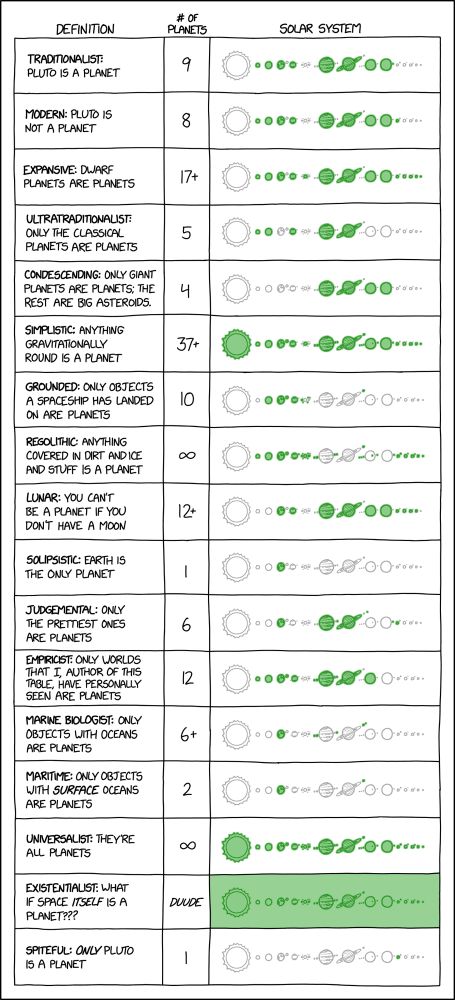
TLDR; The PSF has made the decision to put our community and our shared diversity, equity, and inclusion values ahead of seeking $1.5M in new revenue. Please read and share. pyfound.blogspot.com/2025/10/NSF-...
🧵
@nichollsh.bsky.social
Studying the atmospheres and interior interactions of rocky planets. University of Oxford AOPP (DPhil) https://www.h-nicholls.space

TLDR; The PSF has made the decision to put our community and our shared diversity, equity, and inclusion values ahead of seeking $1.5M in new revenue. Please read and share. pyfound.blogspot.com/2025/10/NSF-...
🧵

True-color image of the Earth’s Western Hemisphere collected at about 2:00 PM Pacific Daylight Saving Time. There’s no atmospheric correction, so the atmosphere gets more opaque at the edges, and there’s a smooth fade from day to night.

True-color image of the Earth’s Western Hemisphere collected at about 2:00 PM Pacific Daylight Savings Time, corrected for Rayleigh scattering. The atmospheric correction enhances the appearance of the land and ocean, but flattens out the atmosphere and introduces a sharp transition between day and night.
Success! @noaa.gov GOES-West full disk, without (left) the Rayleigh correction that 99% of the published imagery uses. I still need to tweak the settings, but I always thought the removal of atmospheric scattering makes Earth look too flat.
Thanks to @stim3on.bsky.social & @simonsat.bsky.social
With @xoplanets.bsky.social, @timlichtenberg.bsky.social, @climatebook.bsky.social, Richard Chatterjee, and Hamish Hay.
25.07.2025 09:04 — 👍 1 🔁 0 💬 0 📌 0In our now-published paper we model the early history of three exoplanets to specifically study the role of tidal heating on their capacity to solidify. A physically robust feedback mechanism can keep them molten, even with relatively thin atmospheres, which may extend to lots of rocky exoplanets.
25.07.2025 09:04 — 👍 18 🔁 8 💬 1 📌 0See also my explainer thread below!
bsky.app/profile/nich...
Finally and importantly, in this paper, we explain the atmospheric abundances inferred from JWST by invoking the photochemical production of SO2 from H2S.
04.07.2025 15:10 — 👍 2 🔁 0 💬 0 📌 0Our models, which include realistic atmosphere structure calculations, show that the radius of this planet has shrunk over its ~5 Gyr lifetime from that of a sub-Neptune to that of a super-Earth at the present day. This also corresponds with age-radius trends in the Kepler Survey.
04.07.2025 15:10 — 👍 0 🔁 0 💬 1 📌 0Instead, this planet has a mostly H2+H2S+SO2 atmosphere and an internal magma ocean which has been sustained across its multi-billion-year lifetime, making it an interesting window into interactions between atmospheres and magma oceans. It is molten by a greenhouse atmosphere and tidal heating.
04.07.2025 15:10 — 👍 1 🔁 0 💬 1 📌 0In this new paper, we show that this planet must have formed rich in HCNS volatiles, particularly sulfur; incompatible with the typical "gas-dwarf" birth interpretation. Our analysis also finds that this planet’s interior must be geochemically reduced, which also opposes the "water-world" scenario.
04.07.2025 15:10 — 👍 0 🔁 0 💬 1 📌 0L 98-59 d is known to have a low density but a high MMW. We calculate its complete evolutionary history using our fully-coupled open source planetary modelling framework (PROTEUS; Nicholls+24).
04.07.2025 15:10 — 👍 1 🔁 0 💬 1 📌 0In our new paper we model the complete evolution of L 98-59 d from 'birth' up to the present day. We show that it cannot be a gas dwarf or a water world; it's a 'hybrid' planet with an H2-rich atmosphere containing H2S and SO2 (photochemistry!), and a deep magma ocean.
@timlichtenberg.bsky.social
Water world
Gas dwarf
Sub-Venus
Bare rocks
Earth-like (define as you will)
Free floating planets

New paper on arXiv today: "Absence of a Runaway Greenhouse Limit on Lava Planets" by Iris Boer,
@nichollsh.bsky.social, and me (arxiv.org/abs/2505.11149). The runaway greenhouse limit is non-existent on molten planets (which is how planets form), questioning the general "habitable zone" concept.
A time-lapse of some images of asteroid (52246) Donaldjohanson during the encounter by Lucy!
Images taken on April 20, 2025, from a distance of 1,600 to 1,100 km.
Credit: NASA/Goddard/SwRI/Johns Hopkins APL
science.nasa.gov/image-articl...
#PlanetSci #SciComm 🧪

Planet Definitions xkcd.com/3063
14.03.2025 16:07 — 👍 10010 🔁 1734 💬 224 📌 165
Enceladus, by Cassini.
Credit: NASA/JPL-Caltech/SSI/CICLOPS/Kevin M. Gill (@kevinmgill.bsky.social)

Skew-T Log-P xkcd.com/3032
02.01.2025 10:30 — 👍 1938 🔁 218 💬 50 📌 47This is the second paper derived from my PhD, and a direct follow-up from arxiv.org/abs/2411.19137
@climatebook.bsky.social @timlichtenberg.bsky.social

Synthetic planet-average emission spectra (1 to ~20 microns) for HD 63433 d and TRAPPIST-1 c at the point of model termination. For HD 63433 d. Instrument bandpasses are marked on the plots.
Additionally, synthetic planet-averaged emission spectra show absorption features associated with mantle redox (fO2). Deep near-isothermal stratospheres also indicate that cool brightness temperatures could be inferred if observed photometrically.
17.12.2024 10:08 — 👍 2 🔁 0 💬 1 📌 0To do this, we develop a new radiative-convective atmosphere model which is integrated into the PROTEUS magma ocean framework.
These models find that TRAPPIST-1 c solidifies within 100 Myr. HD 63433 d maintains a permanent magma ocean.
Our new paper on atmospheric convection on lava worlds is now on arXiv (accepted in MNRAS).
We model the early time-evolution of two terrestrial-mass planets, and find that their atmospheres are not always convective. However, they can still have permanent magma oceans!
arxiv.org/abs/2412.11987
Follow up paper coming soon :)
02.12.2024 09:08 — 👍 1 🔁 0 💬 0 📌 0We used a coupled interior-atmosphere model to simulate how these planets evolve over time. Sometimes they solidify and sometimes they don't - but this strongly depends on the redox state of the mantle.
02.12.2024 09:08 — 👍 1 🔁 0 💬 1 📌 0Excited to share that our paper on atmospheres on lava planets has been accepted in JGR: Planets!
You can find it on arXiv here:
arxiv.org/abs/2411.19137
Looks great! Maybe you could add clouds?
26.10.2023 22:07 — 👍 0 🔁 0 💬 1 📌 0